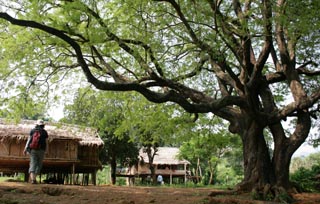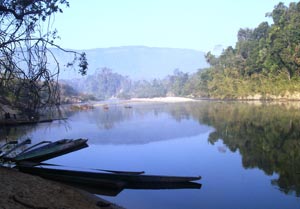Balancing development and conservation
Balancing development and conservation
Author: Wes Ward
Publication Date: Thursday, 22 Aug 2013
Improving the lot of people in a poor, remote village amid a rainforest important for conserving the biodiversity of Laos has been the subject of intensive study by a Charles Sturt University (CSU) researcher.
 Finding a balance between conservation, economic development and traditional culture is a major challenge for managing protected areas in developing countries. It is a challenge CSU postgraduate student Ms Michelle Smith, who is completing a Master of Philosophy by research in environmental management, hopes to address.
Finding a balance between conservation, economic development and traditional culture is a major challenge for managing protected areas in developing countries. It is a challenge CSU postgraduate student Ms Michelle Smith, who is completing a Master of Philosophy by research in environmental management, hopes to address."Protected areas are often vital for conserving endangered plants and animals and the habitats that sustain them," Ms Smith said.
"However, many protected areas in developing countries have failed to protect biodiversity due to conflicts between poverty, access rights, political control and resource use, regardless of the national legislation that established the areas in the first place.
"Through my detailed studies of Korbong village in central Laos, South East Asia, I investigated the potential to develop a balance between conservation and development within a protected area."
 A different management model
A different management modelMs Michelle Smith conducted her research while working for the Nakai Nam Theun Watershed Management and Protection Authority over two years as an Australian Volunteer.
"In my thesis, titled 'Balancing conservation and development in protected areas: A case study from Laos', I studied the effects of local decision making on protected area management, as Lao communities have the rights to use and manage local resources within protected areas," Ms Smith said.
"This is very different to Australia, where most protected areas are located in publicly owned and government managed national parks."
Ms Smith highlighted the close historical ties that the local Brou ethnic group have to the land.
"The local people, about 200 living in up to 60 households, rely on traditional subsistence agriculture and the nearby forest to survive: they grow rain-fed upland rice as well as a little intensive paddy rice; they hunt and collect wood and bamboo in the surrounding rainforest and fish in local streams for food; they also keep a few pigs, chickens and water buffalo for food and sale," she said.
Ms Smith noted it was difficult for villagers to sell their produce in larger towns due to access via river boats being restricted due to relative cost, which also limited further economic development through increased agricultural production.
"So any further restrictions may also inhibit their economic development and the aspirations they hold for their families and the village," Ms Smith said.
"I wanted to see how the national legislation that established the protected area had affected the village people and where they see themselves going in the future, as well as the protected afforded to the nearby protected area."
Core values
Using extensive interviews and group discussions with the help of translators and by personal observations between 2010 and 2012, Ms Smith showed that the villagers had three main core values: 'livelihood security', 'sense of place' and 'village solidarity'.
"These values included a desire to continue village improvements while protecting their local natural environment and village unity," Ms Smith said.
And the villagers wanted these values and community needs incorporated into future development and conservation plans that involved the village.
"They wanted to be engaged in actions that they determine that also include education and local employment," she said.
"This highlighted the need for closer constructive consultation with villagers in park planning, implementation and evaluation.
"This would help create trust between park administrators and villagers and enable social change through mutual learning and joint regulation of activities in the park."
Combating illegal trade
One activity that places pressure on the survival of some endangered plants and animals is illegal international trade in wildlife. This problem was also highlighted by the villagers, who live near the Vietnamese border.
"Local communities and national authorities need to tackle the trade together by understanding barriers to improve engagement with local people and develop culturally appropriate approaches across geographic and political boundaries," Ms Smith said.
"With local and international recognition and commitment, park authorities can restrict the lucrative illegal trade and encourage the conservation of valuable natural resources."
ends
Media contact: Wes Ward, (02) 6051 9906
Media Note:
Contact CSU Media to arrange interviews with researcher Ms Michelle Smith or her supervisor Dr Joanne Millar, a senior researcher with CSU’s Institute for Land, Water and Society.
